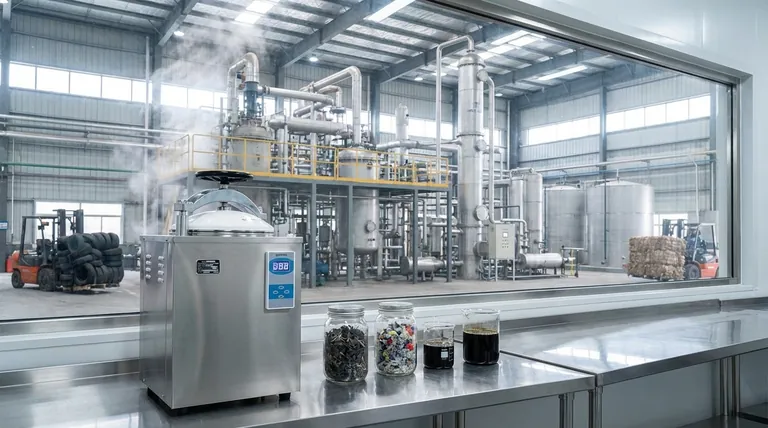The capacity of a pyrolysis machine is not a single, standardized number. Instead, it varies dramatically based on the system's design, ranging from small-scale batch units that process a few hundred kilograms per cycle to large, industrial-grade continuous plants capable of handling over 50 tons of feedstock per day. The specific type of machine—batch or continuous—is the primary determinant of its processing volume.
The most critical insight is not the advertised tonnage per day, but understanding how the system's design (batch vs. continuous) and the specific feedstock dictate the actual, practical throughput and the quality of the final products.

Two Core Types of Pyrolysis Systems
The operational capacity of a pyrolysis plant is fundamentally defined by its core design. These systems fall into two main categories, each suited for different scales and objectives.
Batch Systems: For Smaller Scale Operations
A batch-style machine is loaded with feedstock, sealed, and then run through a complete heating and cooling cycle. Once the process is finished, the outputs (oil, char, gas) are removed, and the reactor is cleaned before the next batch can be loaded.
These systems are simpler and generally have a lower initial cost. Their capacity is typically measured per batch and often ranges from 1 to 15 tons per day, depending on the number of cycles that can be completed.
Continuous Systems: For Industrial Scale
A fully continuous system is designed for non-stop industrial operation. Feedstock is fed into the reactor continuously via a sealed system, and the solid char and other products are discharged simultaneously without shutting the plant down.
These are complex, automated plants built for high efficiency and volume. Their capacity starts where batch systems leave off, typically handling 15 to 50+ tons of feedstock per day.
Key Factors That Define Real-World Capacity
The "nameplate capacity" advertised by a manufacturer is an ideal figure. True operational throughput is influenced by several practical factors.
Feedstock Type and Preparation
The type of material being processed (e.g., tires, plastics, biomass) directly impacts capacity. Denser materials may have higher tonnage, but wet or unprepared feedstock requires significant pre-treatment like shredding and drying, which can become a bottleneck for the entire operation.
Reactor Design and Efficiency
The reactor is the heart of the system. Its design, such as a rotary kiln or fixed bed, determines how efficiently heat is transferred to the feedstock. Better heat transfer leads to shorter processing times and, therefore, higher effective capacity.
Operating Cycle Time
For batch systems, the total cycle time is what matters. A 10-ton reactor that takes 24 hours to load, heat, pyrolyze, cool, and unload has a real-world capacity of 10 tons per day. If that cycle takes 36 hours, the effective capacity drops significantly.
Understanding the Trade-offs: Beyond Input Tons
Focusing solely on how many tons of waste a machine can process is a common oversight. The nature and quality of the output materials are just as critical to the viability of a project.
The Challenge of Output Quality
The primary liquid output, pyrolysis oil (or bio-oil), is not equivalent to refined petroleum products. As a raw product, it has a high oxygen content, making it corrosive, thermally unstable, and immiscible with conventional fossil fuels.
This means the raw oil often cannot be used directly in standard engines or refineries without significant upgrading or post-processing. A high-capacity machine producing low-quality oil may be less valuable than a smaller system designed for higher-quality output.
Efficiency vs. Reality
Advertised capacity figures assume ideal conditions: consistent feedstock, no clogs, and zero downtime. In practice, all industrial plants require routine maintenance and cleaning. These operational realities will always reduce the average daily throughput compared to the theoretical maximum.
Making the Right Choice for Your Goal
Selecting the appropriate capacity requires aligning the technology with your primary objective.
- If your primary focus is small-scale waste management or pilot testing: A batch system with a capacity of 1-10 tons/day offers operational flexibility and a lower initial investment.
- If your primary focus is large-scale, commercial energy production: A fully continuous system capable of processing over 20 tons/day is necessary for achieving the operational efficiency and economy of scale required for profitability.
- If your primary focus is producing high-quality fuel: Your evaluation must prioritize the system's post-processing and oil refining capabilities, not just the raw input capacity of the pyrolysis reactor itself.
Ultimately, evaluating a pyrolysis system on its true operational capability and output quality, not just its nameplate tonnage, is the key to a successful project.
Summary Table:
| System Type | Typical Capacity Range | Key Characteristics |
|---|---|---|
| Batch Systems | 1 - 15 tons per day | Lower initial cost, simpler operation, suited for smaller-scale or pilot projects. |
| Continuous Systems | 15 - 50+ tons per day | Higher efficiency, industrial-scale, designed for non-stop operation. |
Ready to choose the right pyrolysis system for your specific capacity and output quality needs?
KINTEK specializes in providing robust laboratory equipment and consumables for R&D and pilot-scale projects. Whether you are testing feedstock viability or scaling up your process, our solutions support your pyrolysis research with precision and reliability.
Contact our experts today to discuss how KINTEK can equip your lab for success.
Visual Guide

Related Products
- Laboratory Sterilizer Lab Autoclave Vertical Pressure Steam Sterilizer for Liquid Crystal Display Automatic Type
- Laboratory Sterilizer Lab Autoclave Pulse Vacuum Lifting Sterilizer
- Laboratory Test Sieves and Sieving Machines
- Benchtop Laboratory Vacuum Freeze Dryer
- HFCVD Machine System Equipment for Drawing Die Nano-Diamond Coating
People Also Ask
- What to look for when buying an autoclave? A Guide to Selecting the Right Sterilization Technology
- What are the 4 principles of autoclave? Master Steam Sterilization for Your Lab
- What is a lab autoclave? Your Guide to Sterilization with Pressurized Steam
- How does the lab autoclave work? Achieve Complete Sterilization with High-Pressure Steam
- What is the temperature effective for sterilization using autoclave? Achieve Sterile Conditions for Your Lab



















